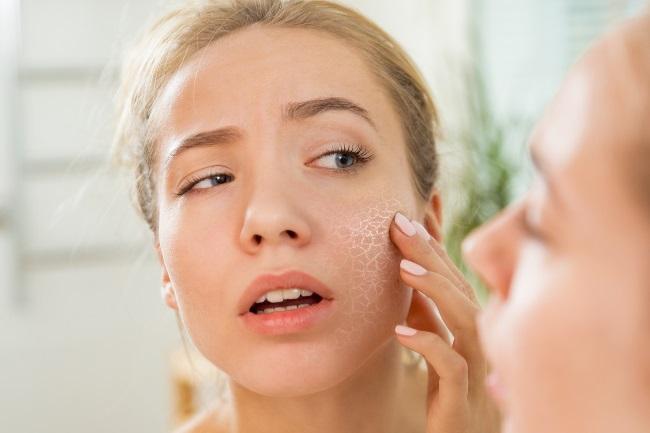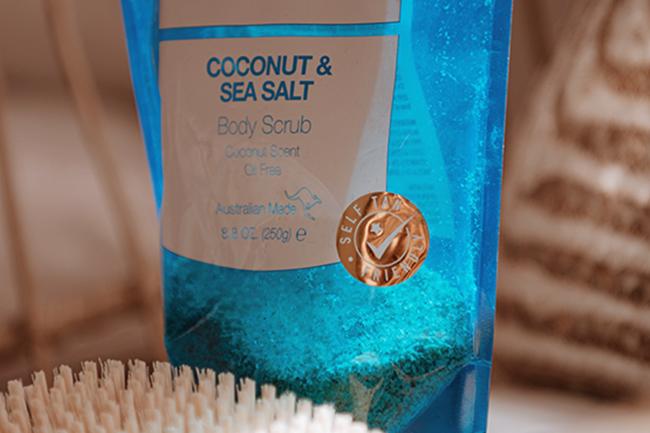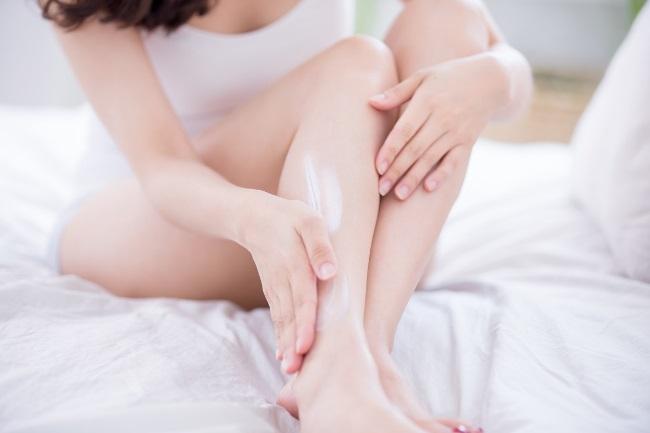We’ve all got unique skin, but its type can generally fit into one of four categories: dry, oily, combination or normal. Dry skin can be difficult to deal with due to its tendency to react sensitively to many products, but what about exfoliation? Let’s find out if exfoliation helps dry skin.
Does exfoliating help dry skin?

We all want to find out whether or not exfoliating can help dry skin, as it can bring many other benefits, such as helping to clear acne, smoothing texture, brightening your complexion, and more, but will it help or harm your dry skin?
The truth is that, yes, exfoliation can help your dry skin, as long as you’re careful with the process and don’t overdo it. It’s important to understand how powerful an exfoliating agent can be, and to work gently with your skin when exfoliating it. Too much exfoliation, which is too harsh, can actually result in exacerbating your dry skin, so we’ll talk about the best way to avoid this later.
The reason behind why exfoliation is good for dry skin is pretty much the same as the reason why exfoliation brings any of its other benefits: increased, healthy cell turnover.
When you exfoliate, you loosen the bonds between dead skin cells on the surface of the outermost layer of the skin – the epidermis – and the skin itself. This means the old, dead skin cells end up ‘falling’ off afterwards, and you’re left with a fresh set of cells on the surface of your skin.
| Benefit | Description |
|---|---|
| Removes dead skin cells | Exfoliating helps to slough off dry and flaky skin, revealing a smoother and more radiant complexion. |
| Enhances moisturizer absorption | By removing the barrier of dead skin cells, exfoliating allows moisturizers to penetrate deeper into the skin, providing better hydration. |
| Stimulates cell renewal | Exfoliating stimulates the skin’s natural cell turnover process, promoting the growth of new, healthier skin cells. |
| Improves skin texture and tone | Regular exfoliation can help improve the texture and tone of dry skin, making it appear smoother, brighter, and more even. |
| Allows better product efficacy | By removing the buildup of dead skin cells, exfoliating allows other skincare products to work more effectively on dry skin. |
| Enhances makeup application | Exfoliating creates a smoother canvas for makeup application, preventing dry patches and allowing for a more flawless finish. |
In turn, this helps your skin as it increases the rate of cell turnover in the skin, which is another way of saying your skin replaces its cells faster. Cell turnover is a completely natural process which happens on its own, anyway, but by removing the dead skin cells faster than they’d normally fall off, you encourage the skin to speed up the entire process itself.
Is exfoliating good for dry skin?
We’ve established that exfoliation can help dry skin, so it must be good for it, right? This is true, but it’s important that you are aware of how the process helps your dry skin. Not all treatments can be good for your skin in the long term, or they might cause an additional concern while they try to solve another.
However, when it comes to exfoliating your dry skin, there’s no need to worry about damaging your skin, as long as you’re gentle.
Because the dead skin cells are removed from your skin, and it replenishes itself quicker, you can often help your dry skin through exfoliation, as it has more opportunity to repair itself.
How can I exfoliate my dry skin?

We’ve already mentioned that you should make sure you’re careful with the way you exfoliate your dry skin, as you should be when exfoliating any skin type, in order to prevent irritation. At the same time, you still want it to be effective, so how can you find a balance?
When exfoliating your dry skin, you first want to start by choosing the best product to suit you. There are two different categories of exfoliants: chemical and mechanical, which both have their own advantages.
Chemical exfoliants are those which contain acids, generally AHAs (Alpha Hydroxy Acids) and sometimes also BHA (Beta Hydroxy Acid, also known as Salicylic Acid, to dissolve the bonds between the dead cells and the healthy skin. On the other hand, mechanical exfoliants are those which use physical particles, such as scrubs, to physically wear away the bonds.
- EXFOLIANT DUO: Elevate your exfoliation routine with this convenient set. Includes both BHA (salicylic acid) and AHA (glycolic acid) products to gently remove dead skin cells & hydrate.
- BRIGHTEN & SMOOTH: Paula's Choice 2% BHA Liquid Exfoliant helps unclog & diminish enlarged pores, exfoliate built-up dead skin, smooth wrinkles & brighten skin tone. Combats redness, wrinkles, aging & blackheads.
- EXFOLIATING FACE WASH - Anti Aging face exfoliator gel that contains 10% Glycolic acid with Lactic Acid. Enhanced with alpha-hydroxy acids (AHA) & beta-hydroxy acid (BHA). This salicylic acid cleanser is able to deeply cleanse, penetrate, unclog & minimize pores of irritants and bacteria. Brightens and helps reduce wrinkles and fine lines.
- PURIFY & RENEW - This AHA BHA exfoliant with botanical passion flower / fruit extract helps to reveal softer, smoother skin with a gentle face scrub exfoliating face wash. A facial exfoliator for women and men that reduces the appearance of fine lines, wrinkles, age-related spots, dark spots, sun spots, discoloration and acne scars.
- HIGH PERFORMING LIQUID EXFOLIATOR – Nip + Fab Glycolic Fix Liquid Glow Extreme is a high performance liquid exfoliator for face. It exfoliates the skin for a more refined skin surface.
- DEEPLY CLEANSE AND COMBATS PORES – This glycolic acid exfoliates, retextures and resurfaces skin by cleansing skin, unclogging and refining pores to reveal clearer and more radiant skin.
If you click Buy on Amazon and make a purchase, I'll earn a small commission at no additional cost to you.
When it comes to dry skin, most people will recommend that you use a chemical exfoliant, and there are a few reasons for this. Firstly, you’re more likely to over exfoliate your skin when using a mechanical scrub, as the particles can be harsh and scratchy, plus the pressure you apply to your skin when exfoliating with one of these makes the difference between smooth skin or shredded skin.
Not to mention, chemical exfoliants can often wind up being more effective as a whole, as they often come in the form of leave-on treatments that get to work on your skin throughout the day, and you can be sure that every area of your face has had its fair share.
Another thing you should consider is the frequency, and this can vary from skin to skin, as it depends how much your skin can handle, as well as the strength of the product. Generally, it’s best to start at once per week and, if your skin manages it well, or you think you need a little more, consider increasing this to two to three times per week.
Alternatively, you can also purchase a mild exfoliant which can be used on your face daily, but make sure this is suitable for dry skin and intended for daily use to avoid overly stripping your skin.
Also read: Does Exfoliating Remove Suntan? (Chemical vs. Physical)
How should I take care of my dry skin when exfoliating it?

When you exfoliate your skin, you should also remember that the aftercare is essential, and your skin is essentially one huge organ, so you need to take care of it.
Arguably the most important thing to remember after you exfoliate your skin is to apply an SPF every day. Your skin is more sensitive to the Sun post-exfoliation, and so it is more susceptible to the damage from UV rays. As you probably know, you should be using a sunscreen every day anyway, but this is particularly important now.
Of course, you should also remember to moisturise and soothe your skin afterwards and protect your moisture barrier. Dry skin can struggle with this anyway, so it’s always good to find a product which can effectively serve this purpose.
Also read:
The Best Way to Exfoliate your Lips (2 Methods)
Final thoughts
In short, you can exfoliate your dry skin to help it, and it will produce effective results. However, it’s crucial for you to remember the correct way to do so and work gently with the skin. and don’t forget the sunscreen afterwards!




